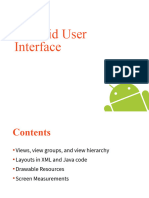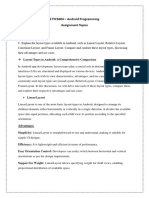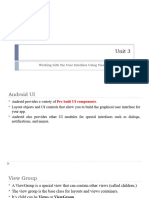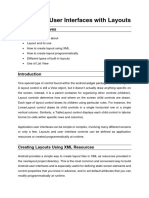0% found this document useful (0 votes)
7 views12 pagesAndroid Layouts Lecture4
The document provides an overview of various Android layout types, including LinearLayout, RelativeLayout, ConstraintLayout, FrameLayout, TableLayout, and GridLayout, along with their functionalities and analogies for better understanding. It emphasizes performance considerations such as avoiding deep hierarchies and preferring ConstraintLayout for complex UIs. Additionally, it poses questions regarding the differences and appropriate use cases for these layouts.
Uploaded by
nareshCopyright
© © All Rights Reserved
We take content rights seriously. If you suspect this is your content, claim it here.
Available Formats
Download as PPTX, PDF, TXT or read online on Scribd
0% found this document useful (0 votes)
7 views12 pagesAndroid Layouts Lecture4
The document provides an overview of various Android layout types, including LinearLayout, RelativeLayout, ConstraintLayout, FrameLayout, TableLayout, and GridLayout, along with their functionalities and analogies for better understanding. It emphasizes performance considerations such as avoiding deep hierarchies and preferring ConstraintLayout for complex UIs. Additionally, it poses questions regarding the differences and appropriate use cases for these layouts.
Uploaded by
nareshCopyright
© © All Rights Reserved
We take content rights seriously. If you suspect this is your content, claim it here.
Available Formats
Download as PPTX, PDF, TXT or read online on Scribd
/ 12






























































